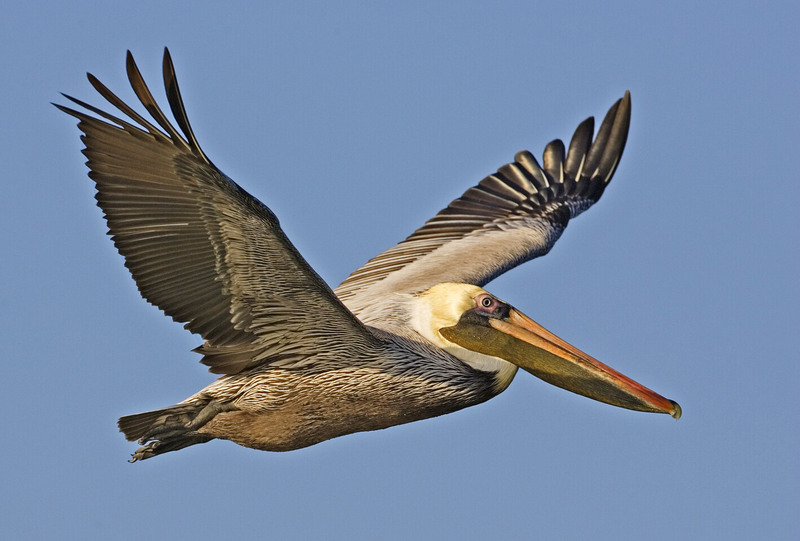Brown Pelican (Pelecanus occidentalis) - wiki Brown Pelican
From Wikipedia, the free encyclopedia
[Photo] Brown Pelican, Fulton Harbour, Fulton, Texas. Author: Alan D. Wilson, www.naturespicsonline.com
The Brown Pelican (Pelecanus occidentalis) is the smallest of the eight species of pelican, although it is a large bird in nearly every other regard. It is 106-137 cm (42-54 in) in length, weighs from 2.75 to 5.5 kg (6-12 lbs) and has a wingspan from 1.83 to 2.5 m (6 to 8.2 ft).
It lives strictly on coasts from Washington and Virginia south to northern Chile and the mouth of the Amazon River. Some immature birds may stray to inland freshwater lakes. After nesting, North American birds move in flocks further north along the coasts, returning to warmer waters for winter.
This bird is distinguished from the American White Pelican by its brown body and its habit of diving for fish from the air, as opposed to co-operative fishing from the surface. It eats mainly herring-like fish. Groups of Brown Pelicans often travel in single file, flying low over the water's surface.
The nest location varies from a simple scrape on the ground on an island to a bulky stick nest in a low tree. These birds nest in colonies, usually on islands.
Pesticides like DDT and dieldrin threatened its future in the southeast United States and California in the early 1970s. Pesticides also threatened the pelican population in Florida in this period. A research group from the University of Tampa headed by Dr. Ralph Schreiber conducted research in the Tampa Bay/St Petersburg area and found that DDT caused the pelican eggshells to be overly-thin and incapable of supporting the embryo to maturity. As a result of this research, DDT usage was eliminated in Florida and the rest of the country.
Along with the American White Pelican, the Brown Pelican is protected by the Migratory Bird Treaty Act of 1918.
There are four subspecies:
P. o. californicus (California Brown Pelican)
P. o. carolinensis (Eastern Brown Pelican)
P. o. occidentalis (Caribbean Brown Pelican)
P. o. thagus (Galapagos Brown Pelican)
The Peruvian Pelican, Pelecanus thagus, used to be considered a subspecies of the Brown Pelican (P. o. thagus). However, due to its well-defined allopatry and because it is much larger and heavier than its relatives, it was reclassified as a separate species.
The Brown Pelican is the state bird of Louisiana.
http://en.wikipedia.org/wiki/Brown_Pelican
| The text in this page is based on the copyrighted Wikipedia article shown in above URL. It is used under the GNU Free Documentation License. You may redistribute it, verbatim or modified, providing that you comply with the terms of the GFDL. |
